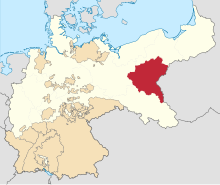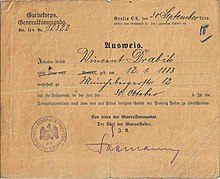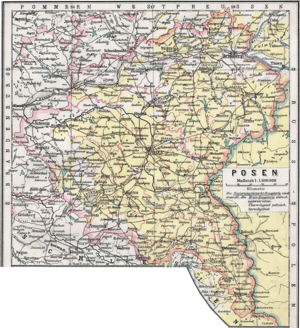Province of Posen
| Province of Posen | |||||||||||
|---|---|---|---|---|---|---|---|---|---|---|---|
| Province of Prussia | |||||||||||
| 1848–1920 | |||||||||||
 Posen (red) within Prussia (white) and the German Empire (white, beige and red) | |||||||||||
| Capital | Poznań | ||||||||||
| Area | |||||||||||
| • Coordinates | 52°24′N 16°55′E / 52.400°N 16.917°E | ||||||||||
• 1910 | 28,970 km2 (11,190 sq mi) | ||||||||||
| Population | |||||||||||
• 1910 | 2,099,831 | ||||||||||
| History | |||||||||||
• Established | 1848 | ||||||||||
• Disestablished | 1920 | ||||||||||
| Political subdivisions | Bromberg | ||||||||||
| |||||||||||
| Today part of | Poland | ||||||||||
The Province of Posen (
Posen (present-day Poznań, Poland) was the provincial capital.
Geography
The land is mostly flat, drained by two major watershed systems; the Noteć (German: Netze) in the north and the Warta (Warthe) in the center. Ice Age glaciers left moraine deposits and the land is speckled with hundreds of "finger lakes", streams flowing in and out on their way to one of the two rivers.
The 29,000 km2 (11,000 sq mi) area roughly corresponded to the historic region of
Typically, an estate would have its
History
A first
At the same time, a Polish national committee gathered at Poznań and demanded independence. The Prussian Army under General Friedrich August Peter von Colomb at first retired. King Frederick William IV of Prussia as well as the new Prussian commissioner, Karl Wilhelm von Willisen, promised a renewed autonomy status.
However, both among the German-speaking population of the province as well as in the Prussian capital,
Nevertheless, when the Prussian troops had finally crushed the Greater Polish revolt, after a series of broken assurances, on 9 February 1849 the Prussian authorities renamed the duchy as the Province of Posen. In spite of that, the territory formally remained outside of the
With the unification of Germany after the Franco-Prussian War of 1870–71, the Province of Posen became part of the German Empire, and the city of Posen was officially named an imperial residence city. Bismarck's hostility towards the Poles was already well known, as in 1861 he had written in a letter to his sister: "Hit the Poles so hard that they despair of their life; I have full sympathy for their condition, but if we want to survive we can only exterminate them."[4] His dislike was firmly entrenched in traditions of Prussian mentality and history. There was little need for discussions in Prussian circles, as most of them, including the monarch, agreed with his views.[5] Poles suffered from discrimination by the Prussian state; numerous oppressive measures were implemented to eradicate the Polish community's identity and culture.[6][7]
The Polish inhabitants of Posen, who faced discrimination and even forced Germanization, favored the French side during the Franco-Prussian War. France and Napoleon III were known for their support and sympathy for the Poles under Prussian rule[8][9] Demonstrations at news of Prussian-German victories manifested Polish independence feelings and calls were also made for Polish recruits to desert from the Prussian Army, though these went mostly unheeded. Bismarck regarded these as an indication of a Slavic-Roman encirclement and even a threat to unified Germany.[10] Under German Chancellor Otto von Bismarck renewed Germanisation policies began, including an increase of the police, a colonization commission, and the Kulturkampf. The German Eastern Marches Society (Hakata) pressure group was founded in 1894 and in 1904, special legislation was passed against the Polish population. The legislation of 1908 allowed for the confiscation of Polish-owned property. The Prussian authorities did not permit the development of industries in Posen, so the duchy's economy was dominated by high-level agriculture.
At the end of World War I, the fate of the province was undecided. The Polish inhabitants demanded the region be included in the newly independent

Following Germany's defeat in World War in 1945, at
Dissolution after 1918
| Posen | Area in 1910 in km2 | Share of territory | Population in 1910 | After WW1 part of: | Notes |
|---|---|---|---|---|---|
| Given to: | 28,992 km2 [11] | 100% | 2,099,831 | Divided between: | |
| Poland | 26,111 km2 [12] | 90% [13] | 93% [13] | Poznań Voivodeship
|
|
| Germany | 2,881 km2 | 10% | 7% | Posen-West Prussia[14]
|
[Note 1] |
Religious and ethnic composition

This region was inhabited by a
The province's large number of resident Germans resulted from constant immigration since the
During the first half of the 19th century, the German population grew due to state sponsored
| Ethnolinguistic composition of the Province of Posen | ||||||
|---|---|---|---|---|---|---|
| year | 1815[16] | 1819[17] | 1837[18] | 1846[19] | 1890[20] | 1910[21] |
| total population[22] | 798,000 | 883,972 | 1,158,608 | 1,343,135 | 1,751,642 | 2,099,831 |
| % Polish-speaking
(including bilinguals)[23] |
73% | 77.0% | 65.3% | 71.7% | 60.1% | 61.5% (or 65%)[21] |
| % German-speaking
(including most of Jews) |
25% | 17.5% | 28.3% | 28.3% | 39.9% | 38.5% (or 35%)[21] |
There is a notable disparity between German statistics gathered by the Prussian administration, and the Polish estimates conducted after 1918. According to the Prussian census of 1905, the number of German speakers in the Province of Posen was approximately 38.5% (which included colonists, military stationed in the area and German administration), while after 1918 the number of Germans in the Poznan Voivodship, which closely corresponded to province of Posen, was only 7%. According to
Statistics
Area: 28,970 km2
Population
- 1816: 820,176
- 1868: 1,537,300 (Bydgoszcz 550,900 - Poznan 986,400)
- 1871: 1,583,843
- Religion: 1871
- Catholics 1,009,885
- Protestants 511,429
- Jews 61,982
- others 547
- Religion: 1871
- 1875: 1,606,084
- 1880: 1,703,397
- 1900: 1,887,275
- 1905: 1,986,267
- 1910: 2,099,831 (Bromberg - 763,947, Posen - 1,335,884)
Divisions

Prussian provinces were subdivided into government regions (Regierungsbezirke), in Posen:
- Regierungsbezirk Posen 17,503 km2
- Regierungsbezirk Bromberg 11,448 km2
These regions were again subdivided into districts called Kreise. Cities would have their own "Stadtkreis" (urban district) and the surrounding rural area would be named for the city, but referred to as a "Landkreis" (rural district). In the case of Posen, the Landkreis was split into two: Landkreis Posen West, and Landkreis Posen East.

Data is from Prussian censuses, during a period of state-sponsored
| District | Name in Polish | Population | German | % | Polish | % | Bilingual | % |
|---|---|---|---|---|---|---|---|---|
| Province of Posen | - | 2,099,831 | 806,720 | 38.4% | 1,278,890 | 60.9% | 11,823 | 0.6% |
| Bromberg Region | - | 763,947 | 379,488 | 49.7% | 378,831 | 49.6% | 4,956 | 0.6% |
| City of Bromberg | Bydgoszcz | 57,696 | 46,720 | 81.0% | 9,350 | 16.2% | 1,557 | 2.7% |
| Bromberg | Bydgoszcz | 96,473 | 58,783 | 60.9% | 37,049 | 38.4% | 590 | 0.6% |
| Czarnikau | Czarnków | 42,287 | 30,016 | 71.0% | 12,027 | 28.4% | 179 | 0.4% |
| Filehne | Wieleń | 33,653 | 23,504 | 69.8% | 9,918 | 29.5% | 217 | 0.6% |
| Gnesen | Gniezno | 56,250 | 21,461 | 38.2% | 34,643 | 61.6% | 129 | 0.2% |
| Hohensalza | Inowrocław | 77,294 | 28,394 | 36.7% | 48,599 | 62.9% | 258 | 0.3% |
| Kolmar in Posen | Chodzież | 76,020 | 61,600 | 81.0% | 13,957 | 18.4% | 427 | 0.6% |
| Mogilno | Mogilno | 49,253 | 14,274 | 29.0% | 34,659 | 70.4% | 194 | 0.4% |
| Schubin | Szubin | 48,304 | 21,035 | 43.5% | 26,799 | 55.5% | 403 | 0.8% |
| Strelno | Strzelno | 37,620 | 7,437 | 19.8% | 30,109 | 80.0% | 67 | 0.2% |
| Wirsitz | Wyrzysk | 67,219 | 34,235 | 50.9% | 32,446 | 48.3% | 495 | 0.7% |
| Witkowo | Witkowo | 29,094 | 4,814 | 16.5% | 24,164 | 83.1% | 91 | 0.3% |
| Wongrowitz | Wągrowiec | 52,574 | 16,309 | 31.0% | 35,955 | 68.4% | 216 | 0.4% |
| Znin | Żnin | 40,210 | 10,906 | 27.1% | 29,156 | 72.5% | 133 | 0.3% |
| Posen Region | - | 1,335,884 | 427,232 | 32.0% | 900,059 | 67.4% | 6,867 | 0.5% |
| Adelnau | Odolanów | 36,306 | 4,681 | 12.9% | 31,537 | 86.9% | 87 | 0.2% |
| Birnbaum | Międzychód | 28,887 | 14,069 | 48.7% | 14,513 | 50.2% | 264 | 0.9% |
| Bomst | Babimost | 63,120 | 30,980 | 49.1% | 31,794 | 50.4% | 214 | 0.3% |
| Fraustadt | Wschowa | 28,914 | 19,663 | 68.0% | 8,902 | 30.8% | 332 | 1.1% |
| Gostyn | Gostyń | 48,326 | 6,528 | 13.5% | 41,720 | 86.3% | 70 | 0.1% |
| Grätz | Grodzisk Wielkopolski | 36,483 | 5,997 | 16.4% | 30,280 | 83.0% | 191 | 0.5% |
| Jarotschin | Jarocin | 51,626 | 9,236 | 17.9% | 42,168 | 81.7% | 197 | 0.4% |
| Kempen | Kępno | 37,050 | 5,933 | 16.0% | 30,697 | 82.9% | 236 | 0.6% |
| Koschmin | Koźmin Wielkopolski | 33,519 | 5,719 | 17.1% | 27,685 | 82.6% | 58 | 0.2% |
| Kosten | Kościan | 47,325 | 5,149 | 10.9% | 42,091 | 88.9% | 50 | 0.1% |
| Krotoschin | Krotoszyn | 46,874 | 15,822 | 33.8% | 30,709 | 65.5% | 324 | 0.7% |
| Lissa | Leszno | 44,579 | 27,451 | 61.6% | 16,659 | 37.4% | 426 | 1.0% |
| Meseritz | Międzyrzecz | 53,306 | 41,059 | 77.0% | 12,207 | 22.9% | 0 | 0.0% |
| Neutomischel | Nowy Tomyśl | 34,292 | 15,700 | 45.8% | 18,481 | 53.9% | 109 | 0.3% |
| Obornik | Oborniki | 55,880 | 22,450 | 40.2% | 33,139 | 59.3% | 245 | 0.4% |
| Ostrowo | Ostrów Wielkopolski | 43,887 | 9,713 | 22.1% | 33,970 | 77.4% | 165 | 0.4% |
| Pleschen | Pleszew | 37,362 | 6,200 | 16.6% | 30,965 | 82.9% | 128 | 0.3% |
| City of Posen | Poznań | 156,691 | 65,319 | 41.7% | 89,351 | 57.0% | 1,311 | 0.8% |
| Posen West | Poznań, Zach. | 43,129 | 7,374 | 17.1% | 35,474 | 82.3% | 236 | 0.5% |
| Posen Ost | Poznań, Wsch. | 49,119 | 14,102 | 28.7% | 34,795 | 70.8% | 174 | 0.4% |
| Rawitsch | Rawicz | 50,523 | 21,253 | 42.1% | 29,150 | 57.7% | 92 | 0.2% |
| Samter | Szamotuły | 66,856 | 17,071 | 25.5% | 49,589 | 74.2% | 143 | 0.2% |
| Schildberg | Ostrzeszów | 37,290 | 5,470 | 14.7% | 31,100 | 83.4% | 718 | 1.9% |
| Schmiegel | Śmigiel | 36,383 | 6,626 | 18.2% | 29,544 | 81.2% | 207 | 0.6% |
| Schrimm | Śrem | 57,483 | 10,017 | 17.4% | 47,088 | 81.9% | 366 | 0.6% |
| Schroda | Środa Wielkopolska | 49,176 | 6,201 | 12.6% | 42,870 | 87.2% | 92 | 0.2% |
| Schwerin | Skwierzyna | 21,620 | 19,729 | 91.3% | 1,722 | 8.0% | 142 | 0.7% |
| Wreschen | Września | 39,878 | 7,720 | 19.4% | 31,859 | 79.9% | 290 | 0.7% |
The German figure includes the German-speaking Jewish population.
Presidents
The province was headed by presidents (German: Oberpräsidenten).
| Term | Name |
|---|---|
| 1815–1824 | Joseph Zerboni de Sposetti |
| 1825–1830 | Johann Friedrich Theodor von Baumann |
| 1830–1840 | Eduard Heinrich Flottwell |
| 1840–1842 | Adolf Heinrich Graf von Arnim-Boitzenburg |
| 1843–1850 | Carl Moritz von Beurmann |
| 1850–1851 | Gustav Carl Gisbert Heinrich Wilhelm Gebhard von Bonin (First term) |
| 1851–1860 | Eugen von Puttkamer 1800–1874 |
| 1860–1862 | Gustav Carl Gisbert Heinrich Wilhelm Gebhard von Bonin (Second term) |
| 1862–1869 | Carl Wilhelm Heinrich Georg von Horn |
| 1869–1873 | Otto Graf von Königsmarck |
| 1873–1886 | William Barstow von Guenther |
| 1886–1890 | Robert Graf von Zedtlitz-Trützschler |
| 1890–1899 | Hugo Freiherr von Wilamowitz-Moellendorff |
| 1899–1903 | Karl Julius Rudolf von Bitter |
| 1903–1911 | Wilhelm August Hans von Waldow-Reitzenstein |
| 1911–1914 | Philipp Schwartzkopf |
| 1914–1918 | Joh. Karl Friedr. Moritz Ferd. v. Eisenhart-Rothe |
Notable people
(in alphabetical order)
(see also Notable people of Grand Duchy of Posen)
- Stanisław Adamski (1875–1967), Polish priest, social and political activist of the Union of Catholic Societies of Polish Workers (Związek Katolickich Towarzystw Robotników Polskich), founder and editor of the 'Robotnik' (Worker) weekly
- Leo Baeck (1873–1956), German rabbi, scholar, and theologian
- Tomasz K. Bartkiewcz (1865–1931), Polish composer and organist, co-founder of the Singer Circles Union (Związek Kół Śpiewackich)
- Wernher von Braun (1912 –1977) German rocket engineer and space architect; a leading figure in the development of rocket technology, from the V1 & V2 to the Saturn rocket that powered the first Moon landing, and credited as being the "Father of Rocket Science"
- Czesław Czypicki (1855–1926), Polish lawyer from Kożmin, activist for the singers' societies
- Michał Drzymała (1857–1937), Polish peasant
- Ferdinand Hansemann (1861–1900), Prussian politician, co-founder of the German Eastern Marches Society
- Paul von Hindenburg (1847–1934), German field marshal and statesman, last President of Germany before Adolf Hitler
- Straż(Guard) society
- Józef Krzymiński (1858–1940), Polish physician, social and political activist, member of parliament
- Milosław
- Bernd Baron von Maydell (1934–2018), German lawyer and author
- Władysław Niegolewski (1819–85), Polish liberal politician and member of parliament, insurgent in 1846, 1848 and 1863, cofounder of TCL and CTG
- Cyryl Ratajski (1875–1942), president of Poznań 1922–34
- Arthur Ruppin (1876–1943), pioneering sociologist, Zionist thinker and leader, co-founder of Tel Aviv
- Sokół (Falcon) magazine
- Antoni Stychel (1859–1935), Polish priest, member of parliament, president of the Union of the Catholic Societies of Polish Workers (Związek Katolickich Towarzystw Robotników Polskich)
- Roman Szymański (1840–1908), Polish political activist, publicist, editor of Orędownik magazine
- Alfred Trzebinski (1902–1946), SS-physician at several Nazi concentration camps executed for war crimes
- Aniela Tułodziecka (1853–1932), Polish educational activist of the Warta Society (Towarzystwo Przyjaciół Wzajemnego Pouczania się i Opieki nad Dziećmi Warta)
- Piotr Wawrzyniak (1849–1910), Polish priest, economic and educational activist, patron of Union of the Earnings and Economic Societies (Związek Spółek Zarobkowych i Gospodarczych)
Notes
- ^ Western fringes of Prussian Greater Poland remained in Germany after 1918. This area included all of county Skwierzyna and portions of counties Wschowa, Babimost, Międzyrzecz, Chodzież, Wieleń and Czarnków (Netzekreis). It contained 12 towns: Piła, Skwierzyna, Bledzew, Wschowa, Szlichtyngowa, Babimost, Kargowa, Międzyrzecz, Zbąszyń, Brójce, Trzciel and Trzcianka. The area was home to significant Polish minority.
References
- ^ ISBN 3-406-54986-1
- ^ Andrzej Chwalba - Historia Polski 1795-1918 Wydawnictwo Literackie 2000 Kraków
- ISBN 3-525-35165-8
- ^ Hajo Holborn: A History of Modern Germany: 1840-1945, Volume 3, page 165
- ^ Bismarck Edward Crankshaw pages 1685-1686 Bloomsbury Publishing, 2011
- ^ Jerzy Zdrada - Historia Polski 1795-1918 Warsaw Wydawnictwo Naukowe PWN 2007; pages 268, 273-291, 359-370
- ^ Andrzej Chwalba - Historia Polski 1795-1918 Wydawnictwo Literackie 2000 Kraków pages 175-184, 307-312
- ^ Bismarck: A Political History, Edgar Feuchtwange, page 157r
- ^ Zarys dziejów wojskowości polskiej w latach 1864-1939 Mieczysław Cieplewicz Wydawn. Ministerstwa Obrony Narodowej, 1990, page 36
- ^ Clark, Christopher (2006). Iron Kingdom: The Rise And Downfall of Prussia, 1600–1947. Harvard University Press. p. 579.
- ^ "Gemeindeverzeichnis Deutschland".
- ^ Weinfeld, Ignacy (1925). Tablice statystyczne Polski: wydanie za rok 1924 [Poland's statistical tables: edition for year 1924]. Warsaw: Instytut Wydawniczy "Bibljoteka Polska". p. 2.
- ^ a b Nadobnik, Marcin (1921). "Obszar i ludność b. dzielnicy pruskiej [Area and population of former Prussian district]" (PDF). Ruch Prawniczy, Ekonomiczny i Socjologiczny. 1 (3). Poznań – via AMUR - Adam Mickiewicz University Repository.
- ^ "Die Grenzmark Posen-Westpreußen Übersichtskarte". Gonschior.de.
- ^ Preußische Ansiedlungskommission
- ^ Historia 1789-1871 Page 224. Anna Radziwiłł and Wojciech Roszkowski.
- ^ Hassel, Georg (1823). Statistischer Umriß der sämmtlichen europäischen und der vornehmsten außereuropäischen Staaten, in Hinsicht ihrer Entwickelung, Größe, Volksmenge, Finanz- und Militärverfassung, tabellarisch dargestellt; Erster Heft: Welcher die beiden großen Mächte Österreich und Preußen und den Deutschen Staatenbund darstellt; Nationalverschiedenheit 1819: Polen - 680,100; Deutsche - 155,000; Juden - 48,700. Verlag des Geographischen Instituts Weimar. p. 43.
- ^ Plater, Leon (1846). Opisanie historyczno-statystyczne Wielkiego Księstwa Poznańskiego. Jan N. Bobrowicz, Leipzig. p. 71.
- ]
- ^ Scott M. Eddie, Ethno-nationality and property rights in land in Prussian Poland, 1886-1918, Buying the land from under the Poles' feet? in S. Engerman, Land rights, ethno-nationality and sovereignty in history, 2004, p.57, [1]
- ^ a b c d Kozicki, Stanislas (1918). The Poles under Prussian rule. London: Polish Press Bur. pp. 3–4.
- ^ a b Leszek Belzyt: Sprachliche Minderheiten im preußischen Staat 1815–1914. Archived 2018-04-20 at the Wayback Machine Marburg 1998, S.17
- ISBN 3-87969-267-X
- ^ "Dzieje Wielkopolski" (red. Witold Jakóbczyk)[permanent dead link]
- ^ Transnationalism in the Prussian East: From National Conflict to Synthesis, 1871–1914. By Mark Tilse. Basingstoke: Palgrave Macmillan. 2011. page 38
- ISBN 0-8131-1803-4. Retrieved 2009-09-05.
- ISBN 0-275-97269-0
- ^ Spisy ludności na ziemiach polskich do 1918 r Archived 2009-06-28 at the Wayback Machine
External links
- . Encyclopædia Britannica. Vol. 22 (11th ed.). 1911. pp. 170–171.
- Administrative subdivision of the province (in 1910)


